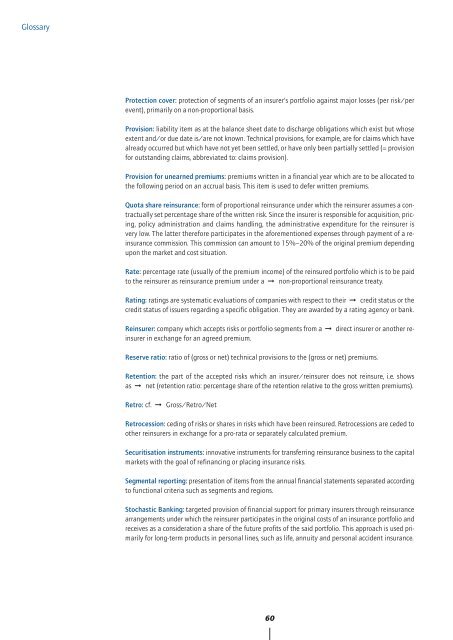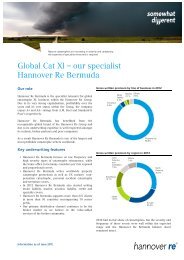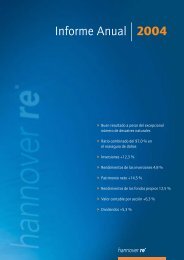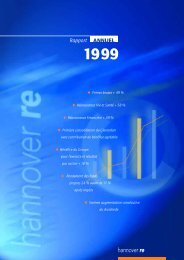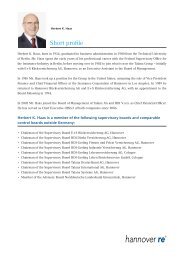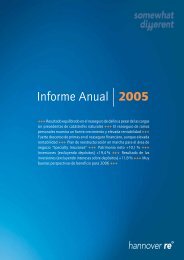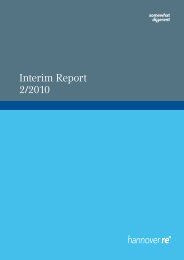Annual Report 2003 - Hannover Re
Annual Report 2003 - Hannover Re
Annual Report 2003 - Hannover Re
You also want an ePaper? Increase the reach of your titles
YUMPU automatically turns print PDFs into web optimized ePapers that Google loves.
Glossary<br />
Protection cover: protection of segments of an insurer's portfolio against major losses (per risk/per<br />
event), primarily on a non-proportional basis.<br />
Provision: liability item as at the balance sheet date to discharge obligations which exist but whose<br />
extent and/or due date is/are not known. Technical provisions, for example, are for claims which have<br />
already occurred but which have not yet been settled, or have only been partially settled (= provision<br />
for outstanding claims, abbreviated to: claims provision).<br />
Provision for unearned premiums: premiums written in a financial year which are to be allocated to<br />
the following period on an accrual basis. This item is used to defer written premiums.<br />
Quota share reinsurance: form of proportional reinsurance under which the reinsurer assumes a contractually<br />
set percentage share of the written risk. Since the insurer is responsible for acquisition, pricing,<br />
policy administration and claims handling, the administrative expenditure for the reinsurer is<br />
very low. The latter therefore participates in the aforementioned expenses through payment of a reinsurance<br />
commission. This commission can amount to 15%–20% of the original premium depending<br />
upon the market and cost situation.<br />
Rate: percentage rate (usually of the premium income) of the reinsured portfolio which is to be paid<br />
to the reinsurer as reinsurance premium under a ➞ non-proportional reinsurance treaty.<br />
Rating: ratings are systematic evaluations of companies with respect to their ➞ credit status or the<br />
credit status of issuers regarding a specific obligation. They are awarded by a rating agency or bank.<br />
<strong>Re</strong>insurer: company which accepts risks or portfolio segments from a ➞ direct insurer or another reinsurer<br />
in exchange for an agreed premium.<br />
<strong>Re</strong>serve ratio: ratio of (gross or net) technical provisions to the (gross or net) premiums.<br />
<strong>Re</strong>tention: the part of the accepted risks which an insurer/reinsurer does not reinsure, i.e. shows<br />
as ➞ net (retention ratio: percentage share of the retention relative to the gross written premiums).<br />
<strong>Re</strong>tro: cf. ➞ Gross/<strong>Re</strong>tro/Net<br />
<strong>Re</strong>trocession: ceding of risks or shares in risks which have been reinsured. <strong>Re</strong>trocessions are ceded to<br />
other reinsurers in exchange for a pro-rata or separately calculated premium.<br />
Securitisation instruments: innovative instruments for transferring reinsurance business to the capital<br />
markets with the goal of refinancing or placing insurance risks.<br />
Segmental reporting: presentation of items from the annual financial statements separated according<br />
to functional criteria such as segments and regions.<br />
Stochastic Banking: targeted provision of financial support for primary insurers through reinsurance<br />
arrangements under which the reinsurer participates in the original costs of an insurance portfolio and<br />
receives as a consideration a share of the future profits of the said portfolio. This approach is used primarily<br />
for long-term products in personal lines, such as life, annuity and personal accident insurance.<br />
60


